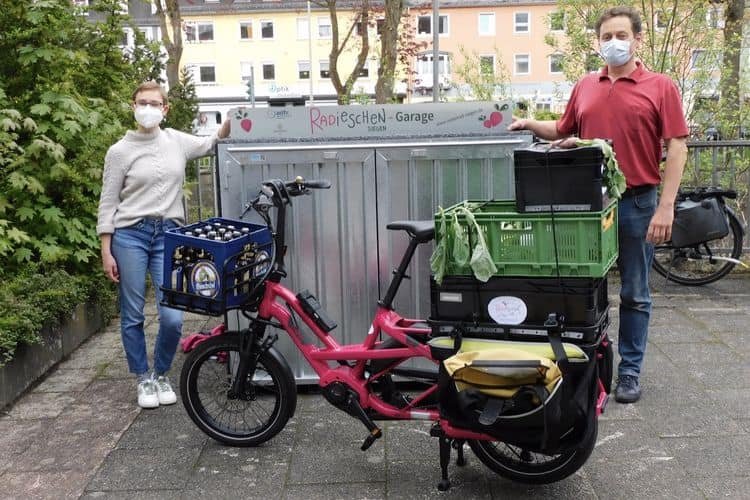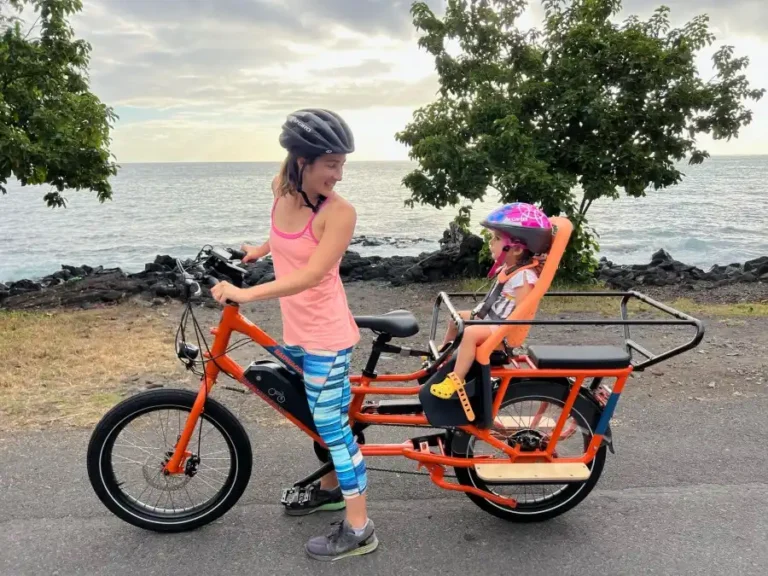Teherautó-kerékpár 101
Alapvető útmutató a teherszállító elektromos kerékpárokhoz – Kulcsfontosságú kifejezések
A miénk Cargo Bike 101 szószedet a legfontosabb terminológiát világos, professzionális magyarázatokba bontja. A kifejezéseket a következő kategóriákba soroltuk: kerékpár alapjai, főbb alkatrészek, hajtáslánc és teljesítmény, elektromos rendszerek és féktechnológia, így könnyen megtalálhatja pontosan azt, amire szüksége van. Akár új az iparágban, akár elmélyíteni szeretné szakértelmét, ez az útmutató segít magabiztosan eligazodni az elektromos kerékpárok és az elektromos teherkerékpárok mögött álló technológiában.
Vázgeometria és szerkezet
Kifejezés | Meghatározás |
Keret | A kerékpár gerince. Összeköti az összes többi alkatrészt és hordozza a terhelést. |
Merev első villa | Tartja az első kereket és lehetővé teszi a kormányzást; felfüggesztés nélkül tervezték. |
Rakománytartó | Teherhordó dobozok vagy rakományok hordozása a lovas mögött vagy előtt. |
Kosár | Elülső vagy hátsó kosár a könnyebb tárgyak szállítására. |
Rakománykabin alváz | Alapkeret, amely az elülső dobozt vagy tartályt tartja. |
Rakománykabin | A teher vagy gyermekek szállítására szolgáló doboz vagy tér a lovas előtt. |
Cargo kabin ülés | Opcionális ülés az első dobozban, gyakran gyermekek számára. |
Kormányzási összeköttetés | A kormányt az első kerékhez csatlakoztatja a hosszúszárú kerékpároknál. |
Védőtető keret ) | Tartószerkezet esővédő vagy gyermekvédelmi előtetőkhöz. |
Kormánycső | Tartja a kormányt, és összeköti a kormányművel. |
Kifejezés | Meghatározás |
Gyémánt keret | Hagyományos, két háromszögből álló vázkialakítás, amely szilárdságot és hatékonyságot kínál. |
Rakománydobozos alváz | Az alapkeret, amely a stabilitás érdekében megtámasztja a rakománydobozt. |
Átlépő keret | Alacsony felsőcsővel ellátott váz a könnyű fel- és leszerelés érdekében, ideális teherkerékpárokhoz. |
Merev villa | Teleszkóp nélküli villa, amely tartósságot és nagyobb teherbírást kínál teherkerékpárokhoz. |
Rakománytartó | Áruk szállítására vagy kiegészítők rögzítésére szolgáló keretre szerelt platform. |
Tengelytávolság | Az első és a hátsó keréktengely közötti távolság; a hosszabb tengelytáv javítja a stabilitást. |
Átlós magasság | A talajtól a felső csőig mért magasság kényelmes állást biztosít a kerékpár felett. |
Fejcső szöge | Az első villa kormánycsövének a talajhoz viszonyított szöge; befolyásolja a kezelhetőséget. |
Középcsapágy leengedése | A középcsapágy és a keréktengelyek közötti függőleges távolság befolyásolja az egyensúlyt. |
Láncvilla hossza | A középcsapágy és a hátsó tengely közötti távolság; a hosszabb láncvillák segítenek a terheléselosztásban. |
Villa dőlésszöge (eltolás) | A kormánytengely és az első kerék érintkezési pontja közötti vízszintes távolság befolyásolja a kormányreakciót. |
Nyom | Az első kerék érintkezési pontja és a kormánytengely közötti távolság; a nagyobb utánfutás javítja a stabilitást. |
Kúpos fejcső | Az alul szélesebb fejcső növeli az első rész merevségét és a kormányzási pontosságot. |
Nyeregcső szöge | A nyeregcső talajhoz viszonyított szöge befolyásolja a pedálozás hatékonyságát és a kerékpáros pozícióját. |
Stack & Reach | A „stack” a középcsapágy és a fejcső teteje közötti függőleges távolság; a „reach” pedig a középcsapágy és a fejcső közötti vízszintes távolság. |
Alsócső megerősítése | További megerősítés az alsó csőben a nagyobb rakománysúly és terhelés kezelése érdekében. |
Kormányszerelvény | Az első kerék mozgását szabályozó rendszer, beleértve a rudazatokat és a csapágyakat. |
Felfüggesztés szerelvény | A lengéscsillapító rendszer, amely javítja a kényelmet egyenetlen utakon. |
Kormánycső | A kormányrúd, amelyet a kerékpáros a kerékpár kormányzásához fog, különböző formákban kapható az ergonómia érdekében. |
Anyagok és gyártás
Kifejezés | Meghatározás |
6061-T6 alumínium | Könnyű, korrózióálló alumíniumötvözet, amelyet általában teherkerékpár-vázakhoz használnak. |
7005 alumínium | Erősebb, de valamivel nehezebb alumíniumötvözet, amely jobb kifáradási ellenállást biztosít. |
Reynolds 853 acél | Kiváló minőségű acélötvözet, amely hegesztés után megerősödik, így egyensúlyt teremt a szilárdság és a kényelem között. |
Króm-molibdén acél (4130) | Tartós acélötvözet, amely szilárdságáról, kifáradási ellenállásáról és sima futásérzetéről ismert. |
Titán keret | Könnyű, rozsdaálló anyag, amely nagy szilárdságot kínál, de prémium áron. |
Hidroformázás | Egy olyan technika, ahol nagynyomású folyadékkal alakítják a fémcsöveket, ami lehetővé teszi az összetett tervek létrehozását. |
TIG hegesztés | Precíz hegesztési módszer, amely tiszta, erős kötéseket biztosít alumínium és acél keretekben. |
ED bevonat (elektroforetikus leválasztás) | Rozsdagátló bevonat, amely meghosszabbítja a fém kerékpárvázak élettartamát. |
Dupla húzású cső | Középen vékonyabb falú és vastagabb végű csövek, amelyek csökkentik a súlyt a szilárdság feláldozása nélkül. |
Belső kábelvezetés | Olyan kialakítás, ahol a kábelek a kereten belül futnak, megvédve azokat a sérülésektől és javítva az esztétikát. |
Kiesők | A rések, ahol a hátsó kerék a vázhoz rögzül; lehetnek vízszintesek (a lánc feszítéséhez) vagy függőlegesek (a kerék könnyű eltávolításához). |
Átmenőtengely | Erősebb tengelyrendszer, amely átmegy a vázon és a kereken, növelve a merevséget és a futómű beállítását. |
ISCG tartók (nemzetközi szabványú láncvezető) | Láncvezető vagy lökhárító védőjének rögzítőpontjai, amelyek gyakran megtalálhatók a középhajtású elektromos tehergépkocsikon. |
Kapcsolódó olvasmányok
Rakodás és kezelés és kerekek
Kifejezés | Meghatározás |
Rakománykapacitás | A teherkerékpár által biztonságosan szállítható maximális súly, beleértve a vezetőt és a rakományt is, jellemzően 100-250 kg között van a kereskedelmi teherkerékpárok esetében. |
Rack tartók | Előre fúrt rögzítési pontok a vázon csomagtartók, gyermekülések vagy egyéb kiegészítők felszereléséhez. |
Integrált keretzár | A keretbe épített zárrendszer lehetővé teszi a gyors biztonságot külső zár nélkül. |
Keréktágulás | A hátsó háromszög kifelé szögelt konstrukciója szélesebb gumiabroncsokat tesz lehetővé, javítva a tapadást és a stabilitást nagy terhelés alatt. |
Kerékagy | A kerék közepe, amely a tengelyt és a csapágyakat tartja. |
Belső cső | A gumiabroncs belsejében található felfújható gumitömlő párnázottságot biztosít. |
Külső gumiabroncs | A kerék úttal érintkező gumi része, amely befolyásolja a tapadást és a tartósságot. |
Lengéscsillapító | Egy felfüggesztési alkatrész, amely csökkenti a rezgéseket és fokozza a menetkomfortot. |
Hajtáslánc és teljesítmény
Kifejezés | Meghatározás |
Áttétel | Az első lánctányér és a hátsó fogaskerék közötti kapcsolat; az alacsonyabb áttételek könnyebb pedálozást biztosítanak, míg a magasabb áttételek javítják a sebességet. |
Szíjhajtású rendszer | Karbantartást nem igénylő alternatíva a láncokkal szemben, amely karbonszállal erősített szíjat használ, csendes és sima működést biztosítva. |
Középhajtású motor integrációja | Olyan kialakítás, ahol a villanymotor a középcsapágy közelében található, optimalizálva a súlyelosztást és a hatékonyságot. |
Többsebességes hajtáslánc | Több sebességfokozatú rendszer, amely jobb hatékonyságot biztosít különböző terepeken és terhelések esetén. |
Egysebességes hajtáslánc | Egyszerű hajtáslánc egyetlen áttétellel, kevesebb karbantartást igényel, de korlátozza a sebesség sokoldalúságát. |
Középcsapágy (BB) | A hajtóművet a vázhoz összekötő csapágyegység, amely lehetővé teszi a sima pedálozást. |
Szíjtárcsa | Egy barázdált kerék, amely a szíjhajtású rendszerben vezeti a szíjat, a hagyományos lánctányérok és kazetták helyett. |
Szénszíjhajtás | Alacsony karbantartást igénylő, zsírmentes alternatíva a láncokkal szemben, csendes és tartós teljesítményt nyújtva. |
Standard villa / Teleszkópvilla | Első villa, amely lehet merev vagy felfüggesztéssel felszerelve a jobb lengéscsillapítás érdekében. |
Szár | Az a rész, amely a kormányt a villához köti, és befolyásolja a kerékpár kezelhetőségét. |
markolatok | Gumi vagy hab bevonatok a kormányon, amelyek javítják a kényelmet és a tapadást. |
Hajtókar | A pedálokat a kerékpár hajtásláncához összekötő fém kar, amely a teljesítményt a kerékpárostól a kerekekhez továbbítja. |
Alsó konzol | A vázon belüli csapágyrendszer, amely lehetővé teszi a hajtókarok szabad forgását. |
Nyereg | A kerékpárülést úgy tervezték, hogy kényelmes legyen a különböző kerékpározási stílusokhoz. |
Nyeregcső | A cső, amely összeköti a nyerget a vázzal és lehetővé teszi a magasságállítást. |
Kazettás / Szabadonfutó | A hátsó sebességváltó csoport, amely meghatározza a kerékpár sebességtartományát és váltási hatékonyságát. |
Motor- és pedálrásegítő rendszerek
Kifejezés | Magyarázat |
Egy motor, amely közvetlenül, fogaskerekek nélkül hajtja a kereket, így tartós, de gurulás közben némi ellenállással rendelkezik. | |
Hajtóműves agymotor | Belső bolygókerekes fogaskerekekkel ellátott motor, amely növeli a nyomatékot és a hatásfokot, miközben csökkenti a motor méretét. |
A középcsapágy közelében elhelyezett motor jobb súlyelosztást és hatékonyságot biztosít. | |
Középhajtású motor nyomatékszorzója | Egy olyan rendszer, amelyben a motor teljesítményét a kerékpár sebességfokozatain keresztül erősítik fel a nagyobb hatékonyság érdekében emelkedőkön és nehéz terheken. |
Túlfeszültség (teljesítménynövelés) | Az akkumulátor feszültségének növelése a motor teljesítményének és sebességének növelése érdekében, bár ez csökkentheti az élettartamot. |
Kerékagy motor | A kerékagyba integrált motor, amely lánc vagy szíj nélkül közvetlenül a kerékre juttatja a teljesítményt. |
Egy érzékelő, amely a kerékpáros pedálozási ereje alapján állítja be a motoros rásegítést a természetes kerékpározási érzet érdekében. | |
Belső fogaskerék-agy | A hátsó agyba zárt váltórendszer alacsony karbantartási igényt és sima váltást biztosít. |
Differenciálmű | Trike-okban (háromkerekű teherbiciklikben) használt rendszer, amely kiegyensúlyozza a bal és jobb kerekek sebességét. |
Kapcsolódó olvasmányok
Elektromos alkatrészek és akkumulátorrendszer
Kifejezés | Meghatározás |
Akkumulátorkezelő rendszer (BMS) | Egy olyan rendszer, amely figyeli és szabályozza az akkumulátor teljesítményét, biztosítva a biztonságot és a hosszú élettartamot. |
Integrált akkumulátorrekesz | Olyan vázkialakítás, amely az alsócsőben helyezi el az akkumulátort a jobb védelem érdekében. |
Intelligens vezérlő | A központi egység, amely szabályozza a motor teljesítményét, az akkumulátor használatát és a különféle elektronikus funkciókat. |
Kijelzőpanel (HMI) | Digitális kijelző, amely mutatja a sebességet, az akkumulátor töltöttségi szintjét és egyéb kerékpározási adatokat. |
Gázasszisztens | Egy vezérlőmechanizmus, amely lehetővé teszi a motoros számára, hogy pedálozás nélkül indítsa el a motort. |
Lítium-kobalt akkumulátor | Magas energiasűrűségéről ismert, ideális könnyű, nagy teljesítményű e-kerékpárokhoz. |
Lítium-vas-foszfát akkumulátor | Hosszú ciklusélettartamot, fokozott hőbiztonságot kínál, megbízható e-kerékpár-konstrukciókban használják. |
Ólom-savas akkumulátor | Nehezebb és olcsóbb akkumulátortípus rövidebb élettartammal, ritkán használják modern elektromos kerékpárokban. |
Kábelköteg | Zökkenőmentes kommunikációt biztosít a motor, a vezérlő, az akkumulátor és az érzékelők összekapcsolásához. |
Integrált kapcsoló | A kormányon található gombpanel a lámpák és a rásegítési szintek vezérléséhez. |
DC átalakító | 48 V-ot 12 V-ra alakít át, hogy biztonságosan táplálhassa a lámpákat, a kürtöt vagy a GPS-rendszert. |
Motor | Erőt biztosít a lovas segítésére, különösen nehéz terhek szállítása esetén. |
Vezérlő | Az elektromos rendszer "agya", amely az akkumulátortól a motorig történő energiaellátást irányítja. |
Megjelenítés | Megjeleníti a sebességet, az akkumulátor töltöttségi szintjét, az energiaellátási módot és egyéb menetadatokat. |
Akkumulátor | Tárolja az áramot a motor és a tartozékok működtetéséhez. |
Érzékelő | Érzékeli a pedál mozgását vagy nyomatékát, hogy ennek megfelelően aktiválja a motort. |
Első lámpa | Láthatóságot biztosít az éjszakai lovagláshoz és a biztonsághoz. |
Hátsó lámpa | Figyelmezteti a mögötted haladó forgalmat a jelenlétedre és a fékezésre. |
Fordulók jelzései | Opcionális balra vagy jobbra kanyarodást jelző lámpák, amelyek javítják a biztonságot. |
Fékrendszer alkatrészei
Kifejezés | Meghatározás |
Féknyereg | Az az alkatrész, amely a féktárcsára rögzül, hogy lelassítsa a kerékpárt. |
Fék főhenger | A tárcsafékrendszerben található hidraulikus szivattyú, amely a fékerőt szabályozza. |
Hidraulikus tárcsafékek | Egy fékrendszer, amely hidraulikus folyadékot használ az erő átvitelére a fékkarról a féknyergekre, így biztosítva az erőteljes és egyenletes fékezést. |
Mechanikus tárcsafékek | Bowdennel működtetett tárcsafékrendszer, amely több kézi beállítást igényel, de könnyebben karbantartható, mint a hidraulikus fékek. |
Négydugattyús féknyereg | Négydugattyús féknyereg a megnövelt fékteljesítmény és a jobb hőelvezetés érdekében, amelyet általában nagy teljesítményű elektromos kerékpárokban és teherkerékpárokban használnak. |
Féktárcsa (tárcsafék) | Egy kör alakú fémtárcsa, amely a kerékagyhoz van rögzítve, amelyre a féknyereg rászorul, hogy súrlódást hozzon létre és lelassítsa a kerékpárt. |
Úszó féktárcsa | Egy lebegő belső és külső gyűrűvel ellátott rotorkialakítás, amely enyhe mozgást tesz lehetővé a hőtágulás kezelése és a vetemedés megakadályozása érdekében. |
E-fék leállító érzékelő | Az elektromos kerékpárok biztonsági funkciója, amely fékezéskor azonnal leállítja a motor teljesítményét, hogy megakadályozza a véletlen gyorsulást. |
1TP2 Teratív fékezés | Egy olyan rendszer egyes elektromos kerékpárokban, ahol a fékezési energiát akkumulátorenergiává alakítják vissza, javítva a hatékonyságot és növelve a hatótávolságot. |
Fékkar karnyúlás beállítása | Egy olyan funkció, amely lehetővé teszi a kerékpárosok számára, hogy testre szabják a fékkar és a kormány közötti távolságot a jobb ergonómia és irányíthatóság érdekében. |
Hőálló szinterezett fékbetétek | Nagy teljesítményű, fémvegyületekből készült fékbetétek, amelyeket úgy terveztek, hogy ellenálljanak a magas hőmérsékletnek és nagy terhelés alatt is erős fékerőt biztosítsanak. |
Gázrugó | Nagy teljesítményű felfüggesztési alkatrész, amelyet gyakran használnak prémium lengéscsillapító rendszerekben. |
Tudásközpont
Legutóbbi bejegyzés
Mit jelentenek valójában az "1., 2. és 3. osztályú" címkék az elektromos kerékpárok számára
Ha e-bringát vásárol - beleértve a teherbringát is -, nagy valószínűséggel találkozik a Class...
Érdemes beszerezni egy elektromos teherbiciklit ?
Bevezetés Ahogy a városok fejlődnek és a fenntarthatóság nem csak egy divatos szóvá válik, az elektromos teherbiciklik - vagy e-cargo biciklik -....
Hogyan ültessünk biztonságosan egy gyereket egy Cargo E-Bike-ra: A Complete Guide
Az Regen-nél gyakran halljuk a családok és a flottavásárlók kérdéseit: "Hogyan szállíthatom biztonságosan a gyermekemet egy...




